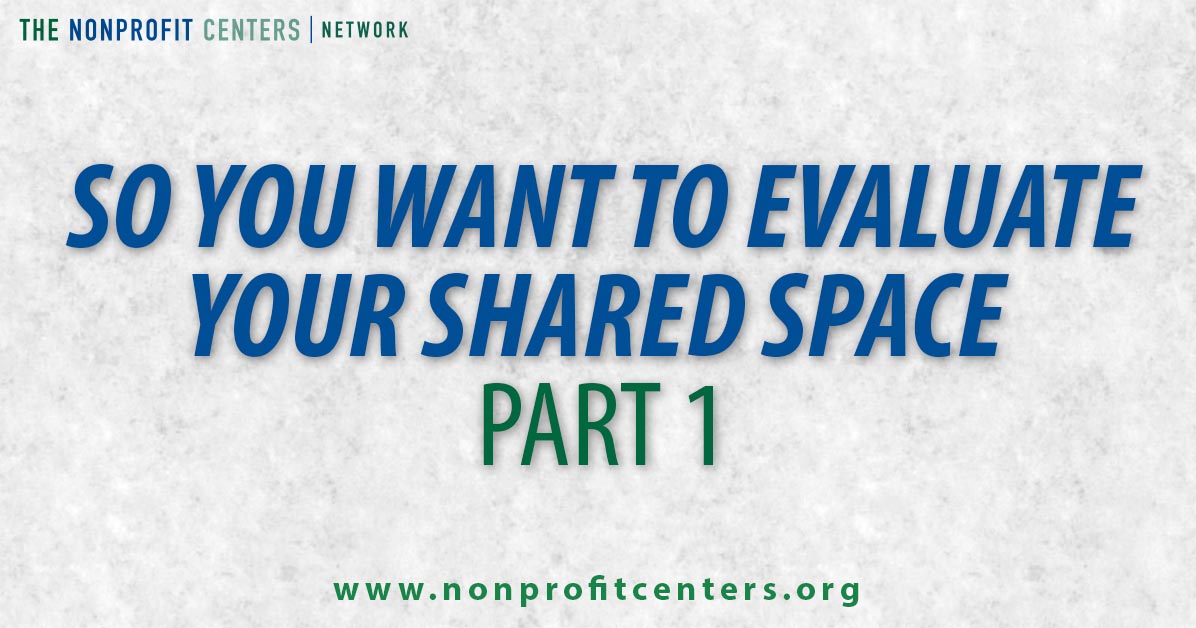NCN started 2017 by kicking off the Evaluation Project, a peer learning opportunity we created with Elena Harman and Laura Sundstrom of Vantage Evaluation. Ten centers are participating in this 9-month process to understand how to approach impact measurement in a rigorous way. Each center will be supported as they complete their own evaluation. This is the first of a series of blogs on what we are learning through this critical process of making the case for shared space.
The advantages to the approach we are using are twofold: first, the centers are essentially sharing the cost of an evaluation professional who would have cost them many times more if they contracted individually; secondly, by working in parallel, the centers are “speed” learning what works in various settings since they can see what their peers are trying and apply those lessons in their center.
We have a great mix of centers: large, small, new and seasoned. We have some centers who are focused on a specific theme or issue area and some that are more general in terms of the types of tenants they house. This has helped us learn more about how different types of centers approach evaluation, why they want to do it and what kinds of information they are seeking.
The process began with each center preparing a logic model or a theory of change. This is impressive in its own right because logic models can be hard to complete for shared spaces. If you don’t have one, please consider working with your staff, board, tenants and stakeholders on it. Logic models can help you focus your thinking about your center and make sure your targeted outcomes are appropriate. Also, the logic model and/or theory of change is the foundation for your evaluation questions. You need to understand your program and precisely what you are trying to accomplish before you can measure your success.
Many of you are already familiar with logic models. It is a way to delineate the inputs, outputs and expected outcomes of your program/organization/nonprofit center. For nonprofit centers, inputs are often the physical space, the staff supporting the center, the technology provided in the center, the mix of tenants and partners, the forums for sharing information and ideas and other similar “raw materials” that you hope will lead to outputs and outcomes.

From our first Evaluation Project homework, we found that nonprofit centers listed the following as examples of outputs in shared space on their logic models:
- Number and diversity of tenants
- Number and type of events/educational programs/community networking opportunities; number of attendees
- Number of media mentions
- Number of one-on-one meetings with tenants to support their goals
- Number of coordinated leadership meetings
- Number and type of discounted back-office services offered
- Number and type of new initiatives to address hard-to-solve community issues
Outcomes are the impact you hope to have based on your inputs and outputs. They can happen in the short, medium and long term. Working on a logic model can help you isolate outcomes that are appropriate for your center evaluation. Here’s what Evaluation Project participants reported were their expected shared space outcomes:
- Increased sustainability of nonprofits
- Development of trusting relationships among tenants as a foundation for collaboration
- Development of meaningful partnerships among tenants
- Best practices will be shared among tenants
- Increased referrals of clients among tenants
- Joint fundraising and events will be held by tenants
- Increased nonprofit/issue area visibility
- Nonprofit center recognized as the “hub” for XYZ issue area
- Improved client services (more types of services, more clients served)
- The community will benefit from better collaboration among tenants
- Mergers of tenant organizations will be facilitated when beneficial
My goal is that this helps others develop their own logic models so they can engage in an evaluation process for their space. Look for my next blog to track along with the progress of the Evaluation Project. I’ll let you know what we learn about appropriate evaluation questions and later, different methodologies for conducting your evaluation and what we learn when all the projects are done! Good luck with your project and please share your insights, challenges and findings with me at [email protected] or in the comments section below.


Does such a thing exist as nonprofit motels? I want to start a nonprofit of this nature, but don’t know people to help me. One 80-unit motel could be managed by one person, weekly rent only – rent rooms 1 – 14 on Mondays, 15 – 25 on Tuesdays, etc for ease of operations. Small rooms, no carpet, no bedding or towels provided (more like an apartment), prison-style bunk beds so two people can share room for same price ($45/wk) as incentive to get more people off the streets. Weekly rent easier for unstable people (as opposed to monthly). Not daily check-in like a regular motel – only weekly, for one manager to handle 80 rooms. On-site coin-op laundry. Interior entries to keep heat/AC in. Windows in rooms don’t open to keep heat/AC in. Rooms include mini fridge, microwave, and TV. 80 rooms at $45/wk = $14,400/mo revenue at 100% occupancy. No need to be subsidized – financially self-sustained after initial investments (built to specifications, purchase land so rent won’t go up). Rent – written in stone – based on 18% Federal Poverty Level. You know people who can help me?
Thank you. Sheri Hoff, Vancouver WA
[email protected]
(My city has 800 – 1,000 homeless. City across the river, Portland OR, has 2,000 – 4,000 people sleeping outside. Homeless women get raped all the time. Woman 30 years old froze to death in Portland last winter – evicted from her subsidized apartment, unable to pay $340/mo.)